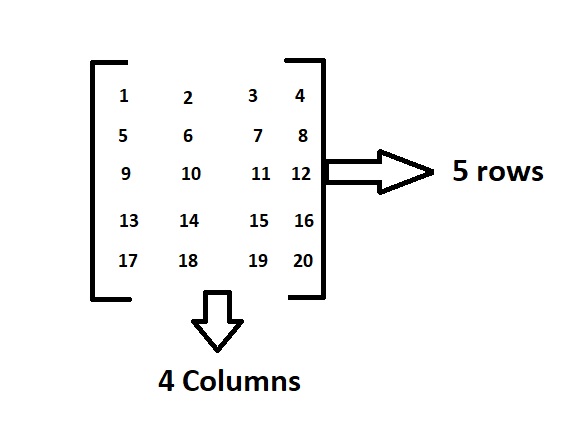In the previous article, we have discussed Python Program to Calculate Sum of all Maximum Occurring Elements in Matrix
Given a number n (which is the size of the matrix)and another number k, the task is to find the frequency of k of the matrix with size n and matrix (i,j)=i+j.
What is a matrix:
A matrix is a rectangular sequence of numbers divided into columns and rows. A matrix element or entry is a number that appears in a matrix.
Example:

Above is the matrix which contains 5 rows and 4 columns and having elements from 1 to 20.
In this order, the dimensions of a matrix indicate the number of rows and columns.
Here as there are 5 rows and 4 columns it is called a 5*4 matrix.
Examples:
Example1:
Input:
Given size of matrix = 3 Given k value = 6
Output:
The given k value{ 6 } frequency in the matix = 1Example2:
Input:
Given size of matrix = 4 Given k value = 3
Output:
The given k value{ 3 } frequency in the matix = 2Program to Count Frequency of k in a Matrix of Size n Where Matrix(i, j) = i+j in Python
Below are the ways to find the frequency of k of the matrix with size n and matrix (i,j)=i+j in python:
Method #1: Using Mathematical Formula (Static Input)
Approach:
- Import math module using the import keyword.
- Give the number(size of matrix) as static input and store it in a variable.
- Give another number k as static input and store it in another variable.
- Create a function to say findfreqencyof_k() which takes the given number(size of matrix) and the given k value as the arguments and returns the frequency of k of the matrix with size n and matrix (i,j)=i+j.
- Inside the function, check if the given number+1 is greater than or equal to the given k value using the if conditional statement.
- If it is true, then return given k value -1.
- Else return (2 * gvn_numb + 1 – gvn_k_val).
- Pass the given number(size of matrix) and the given k value as the arguments to the findfreqencyof_k() function and store it in another variable.
- Check if the above result is less than 0 using the if conditional statement.
- If it is true, then print “The given element k does not exist in the matrix”.
- Else print the frequency of the given k value.
- The Exit of the Program.
Below is the implementation:
# Import math module using the import keyword.
import math
# Create a function to say findfreqencyof_k() which takes the given number(size of matrix)
# and the given k value as the arguments and returns the frequency of k of the matrix
# with size n and matrix (i,j)=i+j.
def findfreqencyof_k(gvn_numb, gvn_k_val):
# Inside the function, check if the given number+1 is greater than or equal to the given
# k value using the if conditional statement.
if (gvn_numb + 1 >= gvn_k_val):
# If it is true, then return given k value -1.
return (gvn_k_val - 1)
else:
# Else return (2 * gvn_numb + 1 - gvn_k_val).
return (2 * gvn_numb + 1 - gvn_k_val)
# Give the number(size of matrix) as static input and store it in a variable.
gvn_numb = 3
# Give another number k as static input and store it in another variable.
gvn_k_val = 6
# Pass the given number(size of matrix) and the given k value as the arguments to the
# findfreqencyof_k() function and store it in another variable.
rslt = findfreqencyof_k(gvn_numb, gvn_k_val)
# Check if the above result is less than 0 using the if conditional statement.
if (rslt < 0):
# If it is true, then print "The given element k does not exist in the matrix".
print("The given element{", gvn_k_val, "} does not exist in the matrix")
else:
# Else print the frequency of the given k value.
print(" The given k value{", gvn_k_val,
"} frequency in the matix = ", rslt)
Output:
The given k value{ 6 } frequency in the matix = 1Method #2: Using Mathematical Formula (User Input)
Approach:
- Import math module using the import keyword.
- Give the number(size of matrix) as user input using the int(input()) function and store it in a variable.
- Give another number k as user input using the int(input()) function and store it in another variable.
- Create a function to say findfreqencyof_k() which takes the given number(size of matrix) and the given k value as the arguments and returns the frequency of k of the matrix with size n and matrix (i,j)=i+j.
- Inside the function, check if the given number+1 is greater than or equal to the given k value using the if conditional statement.
- If it is true, then return given k value -1.
- Else return (2 * gvn_numb + 1 – gvn_k_val).
- Pass the given number(size of matrix) and the given k value as the arguments to the findfreqencyof_k() function and store it in another variable.
- Check if the above result is less than 0 using the if conditional statement.
- If it is true, then print “The given element k does not exist in the matrix”.
- Else print the frequency of the given k value.
- The Exit of the Program.
Below is the implementation:
# Import math module using the import keyword.
import math
# Create a function to say findfreqencyof_k() which takes the given number(size of matrix)
# and the given k value as the arguments and returns the frequency of k of the matrix
# with size n and matrix (i,j)=i+j.
def findfreqencyof_k(gvn_numb, gvn_k_val):
# Inside the function, check if the given number+1 is greater than or equal to the given
# k value using the if conditional statement.
if (gvn_numb + 1 >= gvn_k_val):
# If it is true, then return given k value -1.
return (gvn_k_val - 1)
else:
# Else return (2 * gvn_numb + 1 - gvn_k_val).
return (2 * gvn_numb + 1 - gvn_k_val)
# Give the number(size of matrix) as user input using the int(input()) function
# and store it in a variable.
gvn_numb = int(input("Enter some random number = "))
# Give another number k as user input using the int(input()) function and
# store it in another variable.
gvn_k_val = int(input("Enter some random number = "))
# Pass the given number(size of matrix) and the given k value as the arguments to the
# findfreqencyof_k() function and store it in another variable.
rslt = findfreqencyof_k(gvn_numb, gvn_k_val)
# Check if the above result is less than 0 using the if conditional statement.
if (rslt < 0):
# If it is true, then print "The given element k does not exist in the matrix".
print("The given element{", gvn_k_val, "} does not exist in the matrix")
else:
# Else print the frequency of the given k value.
print(" The given k value{", gvn_k_val,
"} frequency in the matix = ", rslt)
Output:
Enter some random number = 4
Enter some random number = 3
The given k value{ 3 } frequency in the matix = 2Dive into numerous Python Programming Language Examples for practice and get the best out of the tutorial and learn python one step at a time.
